Electrically-powered cars have been in the news more and more in recent years but they have actually been around since the 1800s. In fact, between 1900 and 1912, a third of all vehicles on US roads were powered by electricity, However, when the internal combustion engine (ICE) improved in reliability and performance, electric cars were pushed into extinction as their performance stagnated. After the 1930s, there was little interest in such cars.
It would not be until the 21st century began that pure electric cars would make a comeback, although the hybrid powertrain which used an electric motor with an ICE debuted just as the 20th century was ending. The electrification of cars got underway and this decade will see a surge of models appearing as a number of companies have them in final stages of development.
The early electric cars have had limited performance which raised the question of whether one of the elements of driving pleasure – high performance – would eventually be lost. Hybrid technology advanced a lot and showed that it was possible to have electrification and high performance – but that still included a ICE. What about a pure electric propulsion system?
Full electric but with Porsche DNA
With the new Taycan, launched today in Malaysia by Sime Darby Auto Performance (SDAP) , Porsche shows that high performance need not be lost just because of electrification. Just as its engineers made sure that when the company introduced its first SUV, it would still have the dynamics of a sportscar and the character of a Porsche, they also made sure that the brand’s first all-electric car would do justice to the name ‘Porsche’.
Actually, an electrified car is not entirely new to Porsche and with much attention given to the pioneering Toyota Prius hybrid, and Nissan LEAF and Tesla electric cars, the company reminded the world that Dr. Ferdinand Porsche designed what can be considered the world’s first hybrid powerplant for a car back in the late 1890s. And it was even produced until 1915 although only a small number of cars were actually sold.
Advanced battery technology
100 years later, automotive technology has of course progressed greatly, along with the technologies more specific to electric cars, such as battery technology. Porsche has stayed at the forefront of the technological envelope and used the latest hardware for the Taycan which began as the Mission E concept 5 years ago.
For example, the Taycan is the first production electric vehicle with a system voltage of 800 volts, instead of the usual 400 volts. This is a particular advantage for owners while on the move as full recharging of the lithium-ion battery pack can be done in just over 36 minutes. However, this requires a 175 kW direct current (DC) charger.
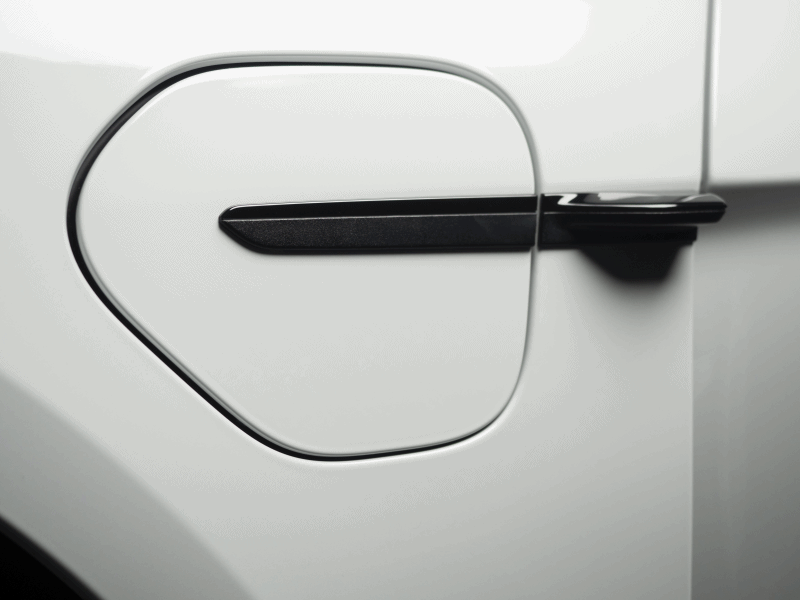
The overall capacity of the Performance Battery Plus is 93.4 kWh and can conduct higher currents, thus speeding up the charging process significantly. Taycan drivers can also charge their cars with up to 11 kW of alternating current (AC) at home using the Porsche Mobile Charger Plus kit. The car can also be recharged at public charging stations, some of which do have the DC facility.
Those who are close enough to a Porsche Centre in Malaysia can get free use of the DC chargers installed at each location. During the charging time of around half an hour, the owner can enjoy a cup of coffee at the lounge or even do some work.
Porsche performance levels
Energy from the battery pack, located under the middle of the car, powers the electric motors which can generate up to 560 kW (761 ps) overboost power in combination with Launch Control in the flagship Taycan Turbo S, and up to 500 kW (680 ps) in the Taycan Turbo. If you wonder why ‘Turbo’ is used when there is no turbocharger, it’s just Porsche’s way of providing a sort of reference point to the relative performance levels of the models.
There’s also a third model – the Taycan 4S – which has a standard Performance Battery. This gives a performance level of up to 390 kW (530 ps) via overboost power in conjunction with Launch Control. It can be increased to a maximum of 420 kW (571 ps) with the optional Performance Battery Plus.
As would be expected, the performance numbers reflect the high torque characteristic that electric motors generate from almost standstill. The Taycan Turbo S, with 1,050 Nm of torque will go from 0 to 100 km/h in a claimed 2.8 seconds while the Taycan Turbo, with 850 Nm, does the same run in 3.2 seconds. The Taycan 4S is no slowpoke either and will still do 0 to 100 km/h within 4 seconds and get up to 250 km/h.
The profile of the driving modes essentially follows the same philosophy as in other Porsche models. This is supplemented by special settings which enable optimum use of the electric drive. Sport Plus and Individual modes are part of the Sport Chrono Package, which comes as standard on the Taycan Turbo S.
So in as far as straightline performance is concerned, these Porsches can provide the same adrenalin rush as their ICE brothers. However, the feeling won’t be the same with the electric motors being smoother as there isn’t that distant reverberation from reciprocating pistons that can be discerned through the steering wheel and pedals.
Perhaps Porsche engineers are working on creating some sort of ‘classic feel’ but for now, there is the Porsche Electric Sport Sound. This is basically a sound clip that comes on during acceleration, adding a sense of ‘drama’ in spite of the electric whine. In some markets, it’s an optional feature but SDAP has specified it as standard for all the Taycan models.
How far can you go?
What about range? This is something that is on the minds of most people who consider an electric car because you can’t just pull into a station to get extra volts when you need them. The recharging network is growing but nowhere close in coverage to the petrol station network which is the product of over 100 years.
Just like the ICE Porsches, the more powerful the car, the less range it will have (and how the car is driven is still a factor). In this case, the range is dependent on the capacity of the battery pack. The 79.2-kWh battery pack of the Taycan 4S can last for a claimed range of 408 kms and if the owner installs the Performance Battery Plus upgrade with about 18% more capacity, the range can be extended another 55 kms. The more expensive Taycan Turbo and Turbo S come with the 93.4-kWh battery pack and for the former, the range is claimed to be up to 452 kms while for the latter, it’s between 390 and 416 kms.
While the ICE is non-existent, there are still many elements of the Taycan which are still ‘conventional’ and familiar. Around the chassis, there’s still adaptive air suspension with 3-chamber air springs and Porsche Active Suspension Management (PASM). The double wishbone front axle and multi-link rear axle are of aluminium and at each wheel are Porsche Ceramic Composite Brake discs.
Futuristic look but still familiar
While Toyota sought to make an impact with a ‘futuristic look’ for the world’s first mass-produced hybrid car, Porsche’s designers have given their first all-electric model a blend of a familiar form with some advanced styling elements. We were already given a preview with the Mission E concept in 2015 and many of the ideas of designer Mitja Borkert have been retained.
The traditional Porsche form (with a Cd of 0.25) is evident, with the Panamera coming to mind. The LED matrix headlights which form a visual unit with the air curtains, provide a futuristic touch. The 4-point daytime running lights that are typical of the brand are flatter and wider than any other Porsche.
The lighting technology includes PDLS Plus where the matrix deactivates segments of the permanent high beam cone in a targeted way. 84 individually controlled LEDs can be adjusted as required by switching off or being dimmed so specific areas ahead can be fully illuminated.
Look of 1963 – as well as tomorrow
As with the exterior, the designers also gave the interior a familiar look and feel. They even looked to the original 911 from 1963 for inspiration when designing the dashboard. The freestanding 16.9-inch curved instrument cluster forms the highest point on the dashboard while a central, 10.9-inch infotainment display and an optional passenger display are combined to form an integrated glass band in a black-panel look and provides the ‘look of tomorrow’.
All user interfaces have been completely re-designed for the Taycan. The number of traditional hardware controls, such as switches and buttons, have been greatly reduced. Instead, control is intelligent and intuitive – via touch operation or voice control.
Sustainability is a big thing in manufacturing today and the sustainable concept of the electric sports car is promoted by offering an entire leather-free interior standard for the Taycan Turbo S and Taycan Turbo (option for the Taycan 4S). The upholstery uses Race-Tex microfibre, a textile partly made from recycled polyester fibres while the flooring is of Econyl recycled fibre, made from recycled fishing nets.
As safe as any Porsche
Needless to say, all the active safety systems are provided and there are up to 8 airbags around the cabin to cushion the occupants from serious injuries. The Taycan has already been tested by EuroNCAP which gave it a maximum score of 5 stars. While the lightweight bodywork structure is conventional in one sense, it has also had to take into consideration the presence of the high-voltage battery pack which is cleverly integrated into the bodyshell structure.
The crash sensors of the Taycan were developed to meet the specific requirements of electric vehicles. Additional sensors are therefore used to reliably disconnect high-voltage equipment in the event of a crash. Also in the event of an accident where the airbag is deployed, the battery connection to the vehicle is disconnected as a precaution so that no voltage is live.
First deliveries in 2021
Prices for the Taycan start from RM725,000 for the Taycan 4S, RM999,000 for the Taycan Turbo, and RM1,195,000 for the Taycan Turbo S – all with applicable taxes but without insurance. Unfortunately, you will have to pay the full sales tax as the first deliveries can only start from the first quarter of 2021, after the expiry of the exemption period.
Click here to find out more about Porsche’s first all-electric sportscar.
The new McLaren 765LT has landed in Malaysia, making its local debut today at the McLaren Kuala Lumpur showroom in Glenmarie.
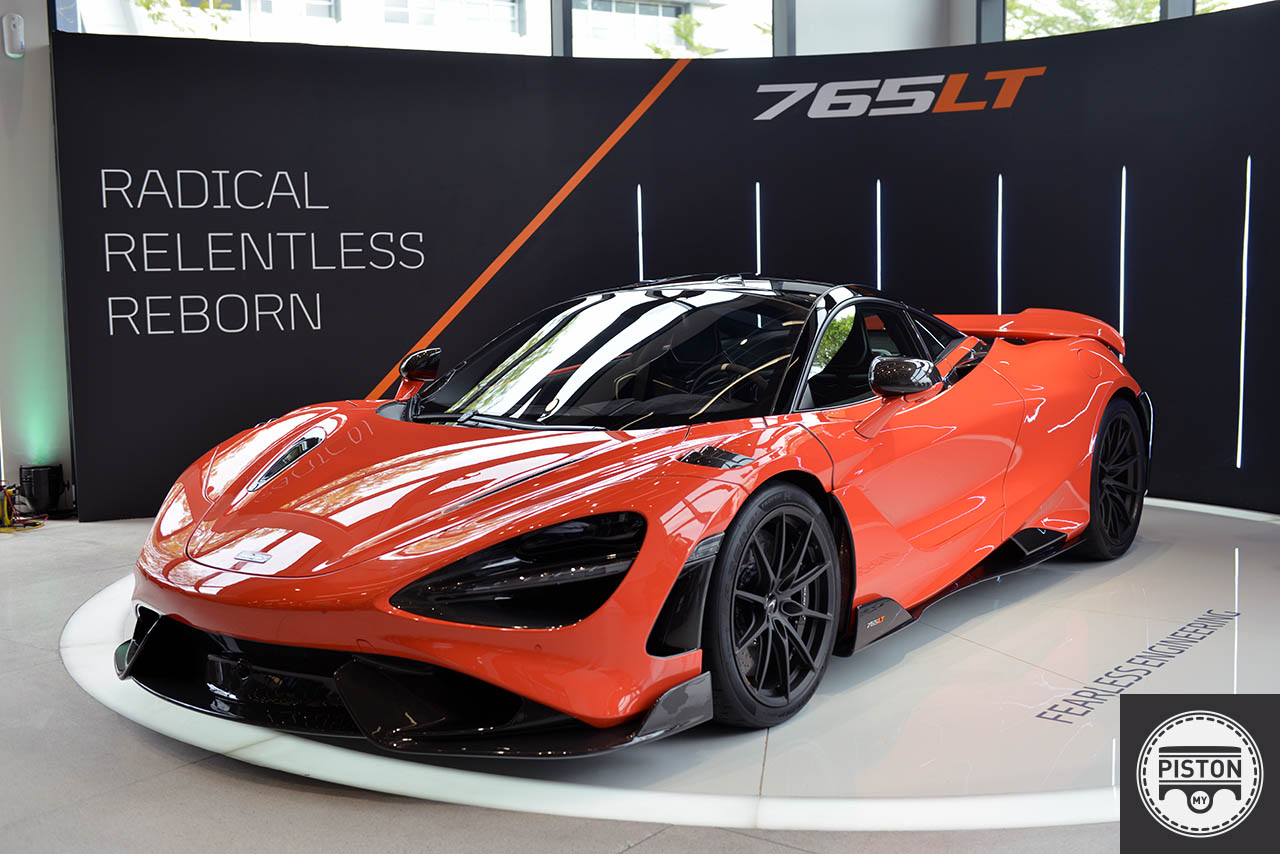
It is undoubtedly a very special car because for a car enthusiast, it represents everything a hypercar should be – dramatic, powerful and very clever.
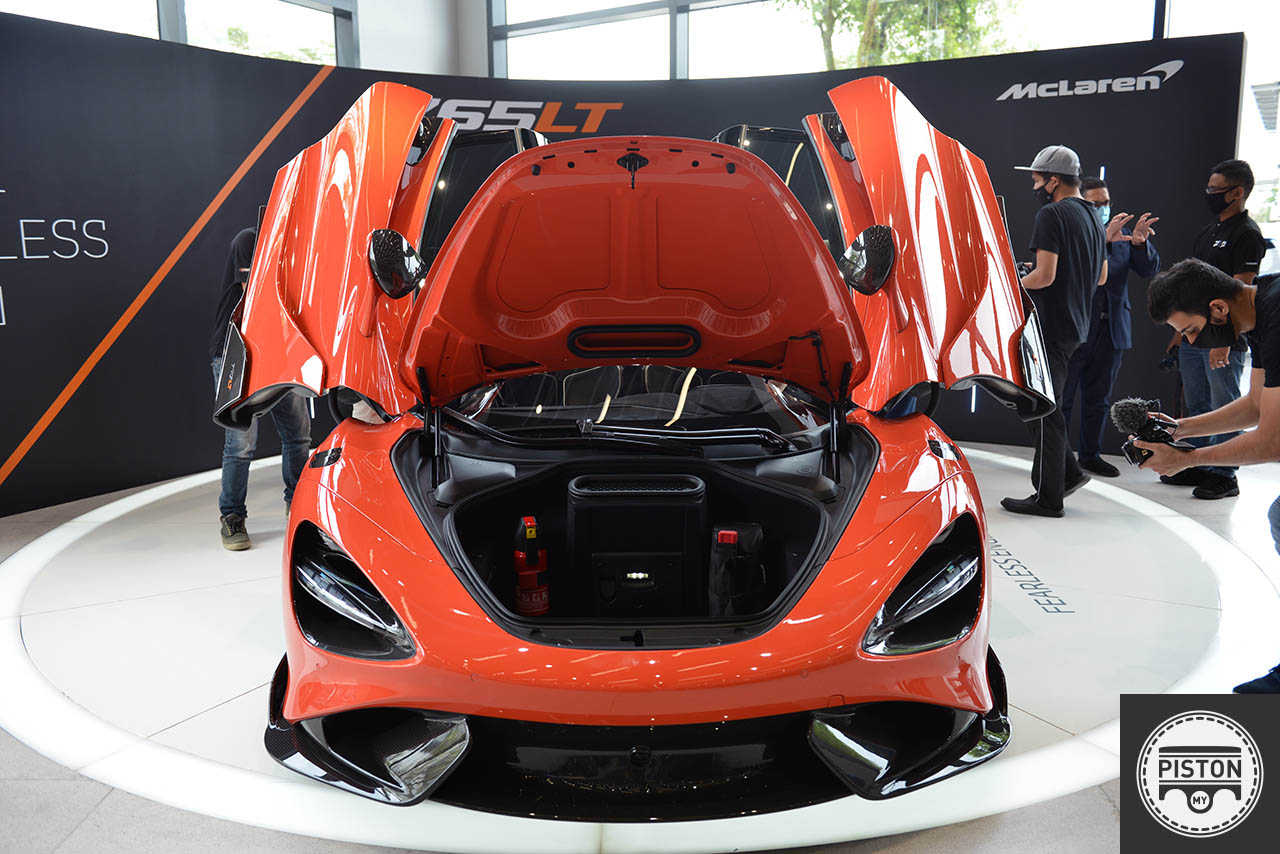
Lets get one thing out of the way first before going further – the LT in its name stands for Longtail. McLaren has a long history of creating Longtails that goes back all the way to 1995 when the McLaren F1 GTR Longtail was introduced to race in the FIA GT Championship.
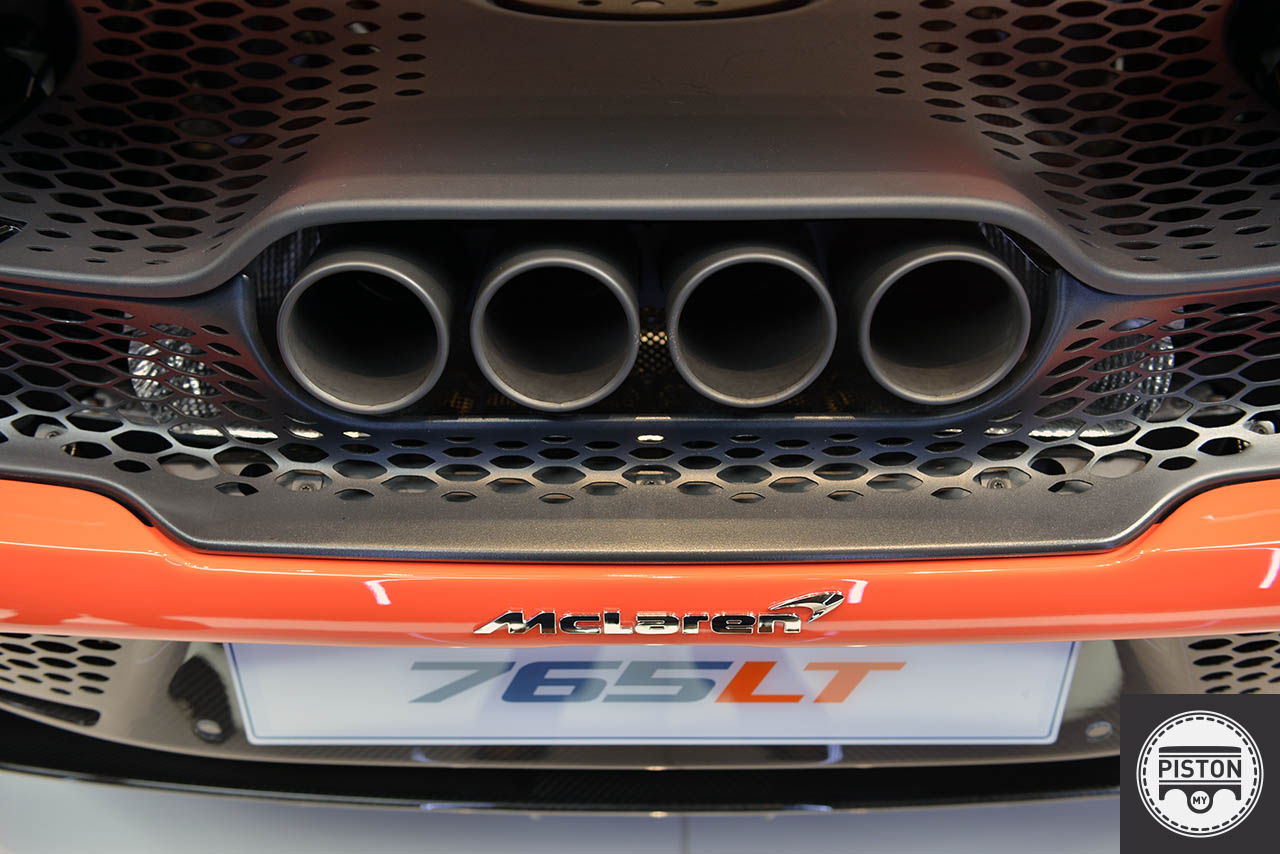
Over the next decade, the F1 GTR Longtail competed in about 120 races and won 38 of those races. Race fans will also know that the McLaren F1 GTR Longtail also competed in the legendary 24 Hours of Le Mans.
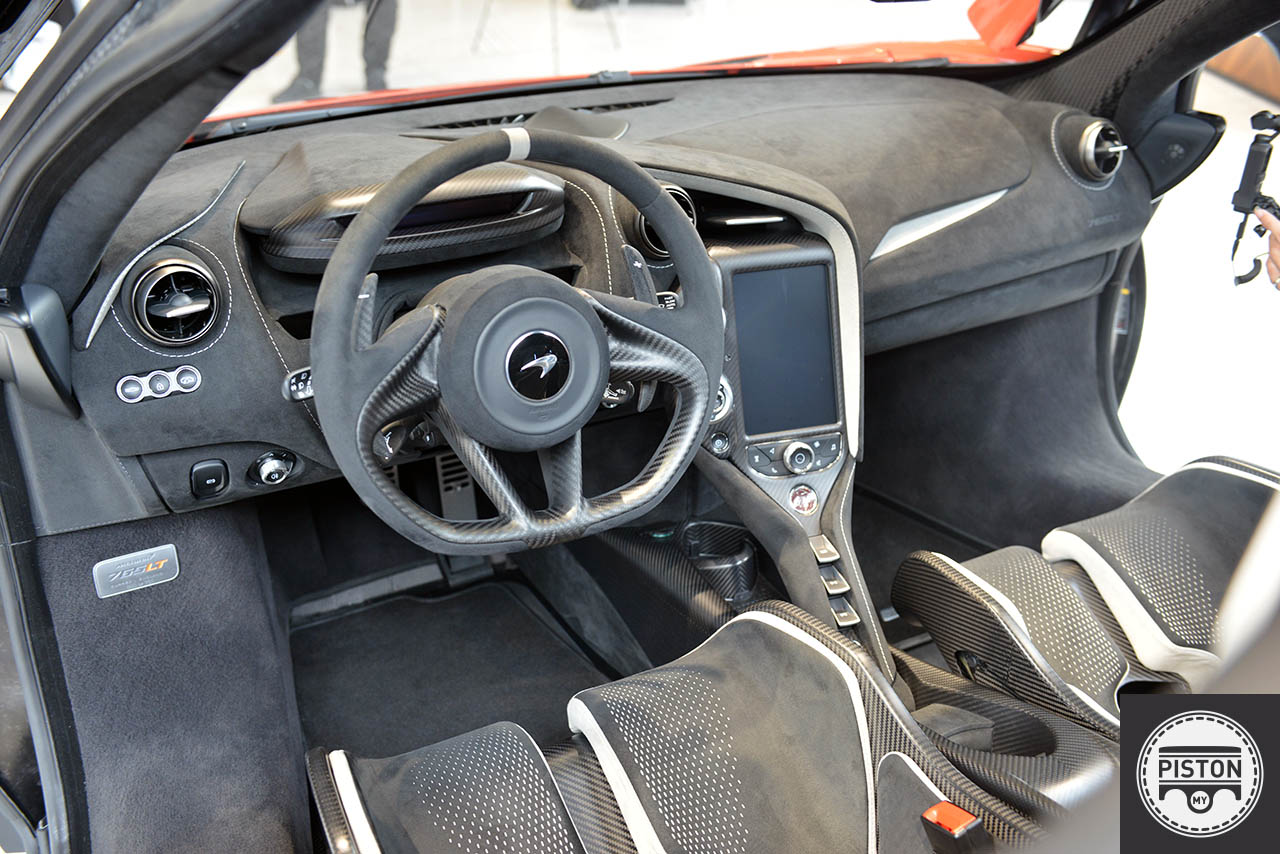
But here’s the curve ball – McLaren now says that the LT now means a step up in performance and does not simply mean that it has a longer tail. It is the same as Ferrari introducing a Speciale or Lamborghini introducing a Performante. It is basically the more hardcore version of the car it is based on.
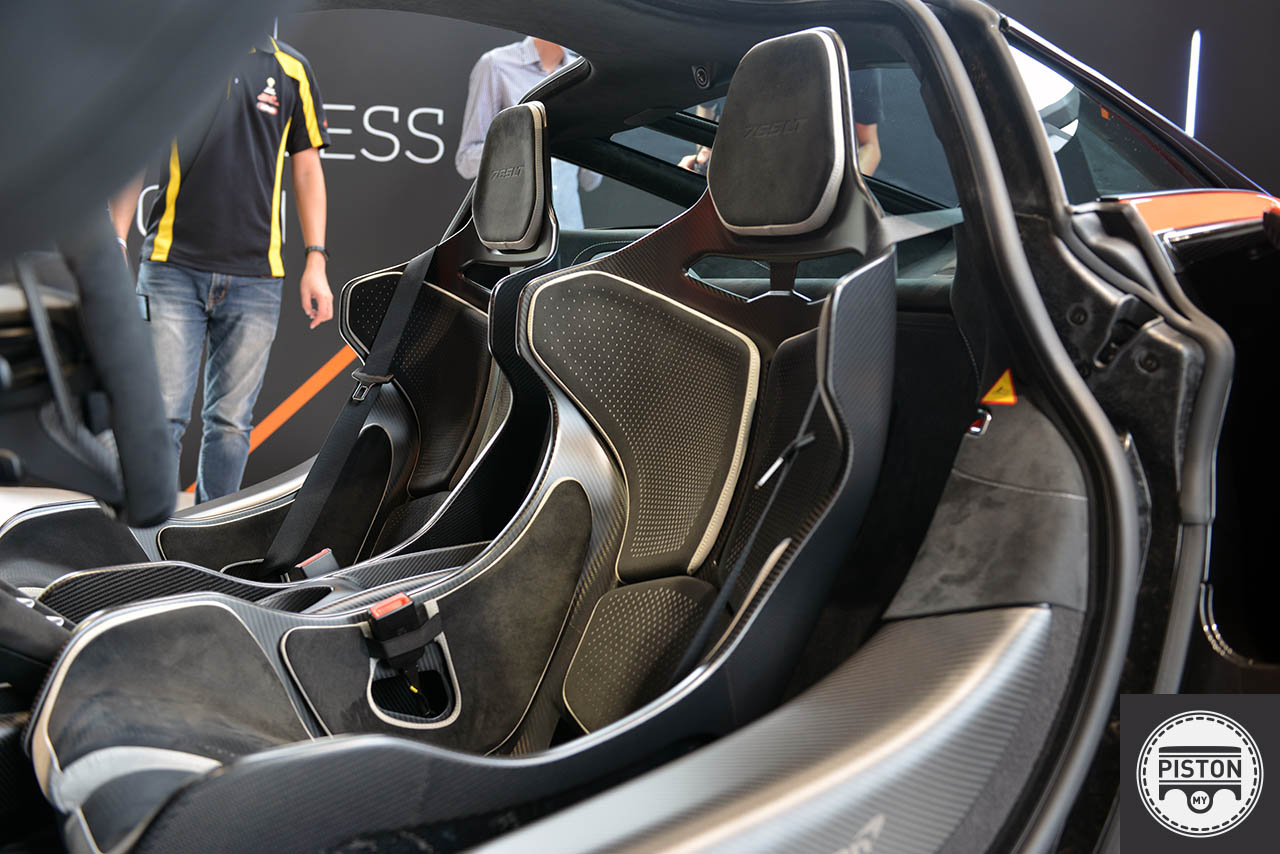
Talking about cars to be based on – the new 765LT is based on the 720S.
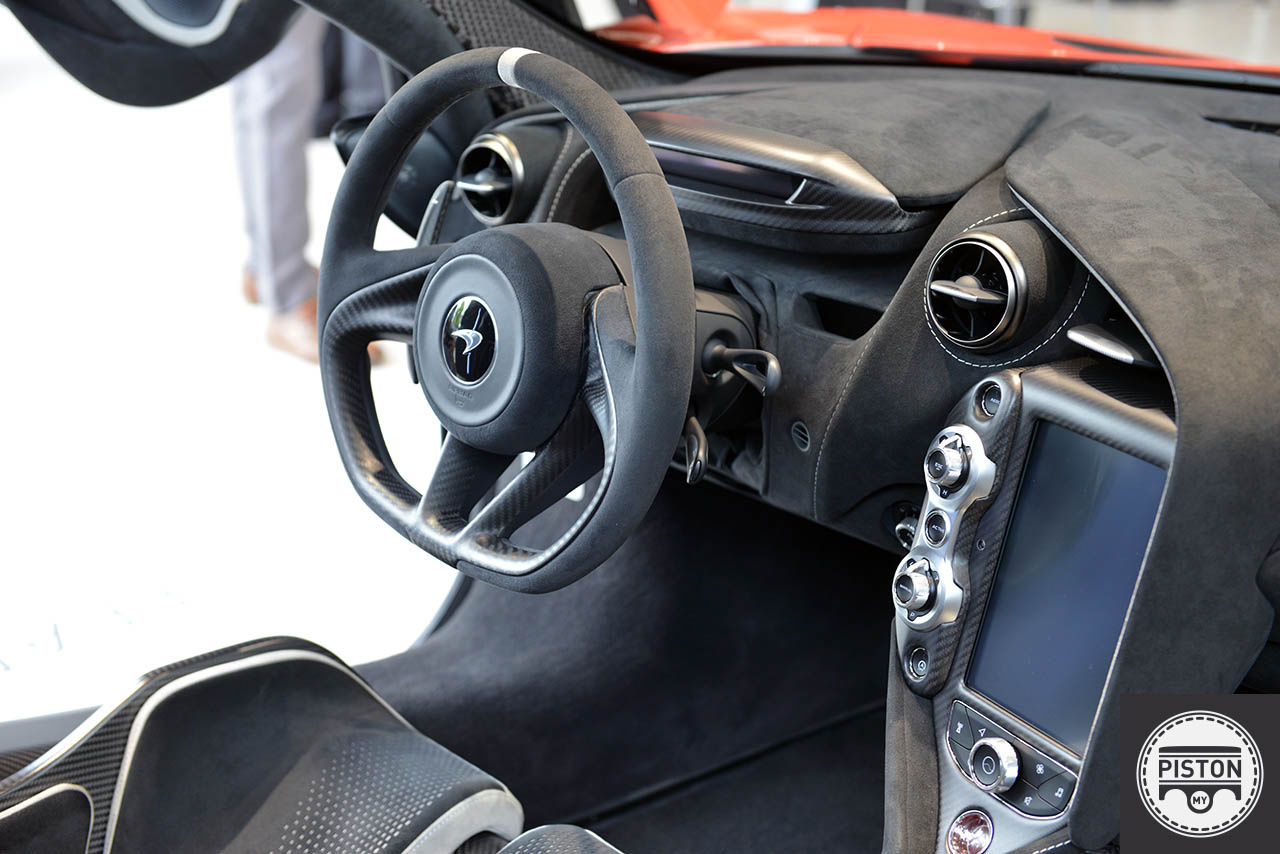
It is both longer and lighter than the base car, and it also uses advanced electronics to create 25% more downforce than the 720S. And as the name suggests, it puts out a staggering 765 horsepower.
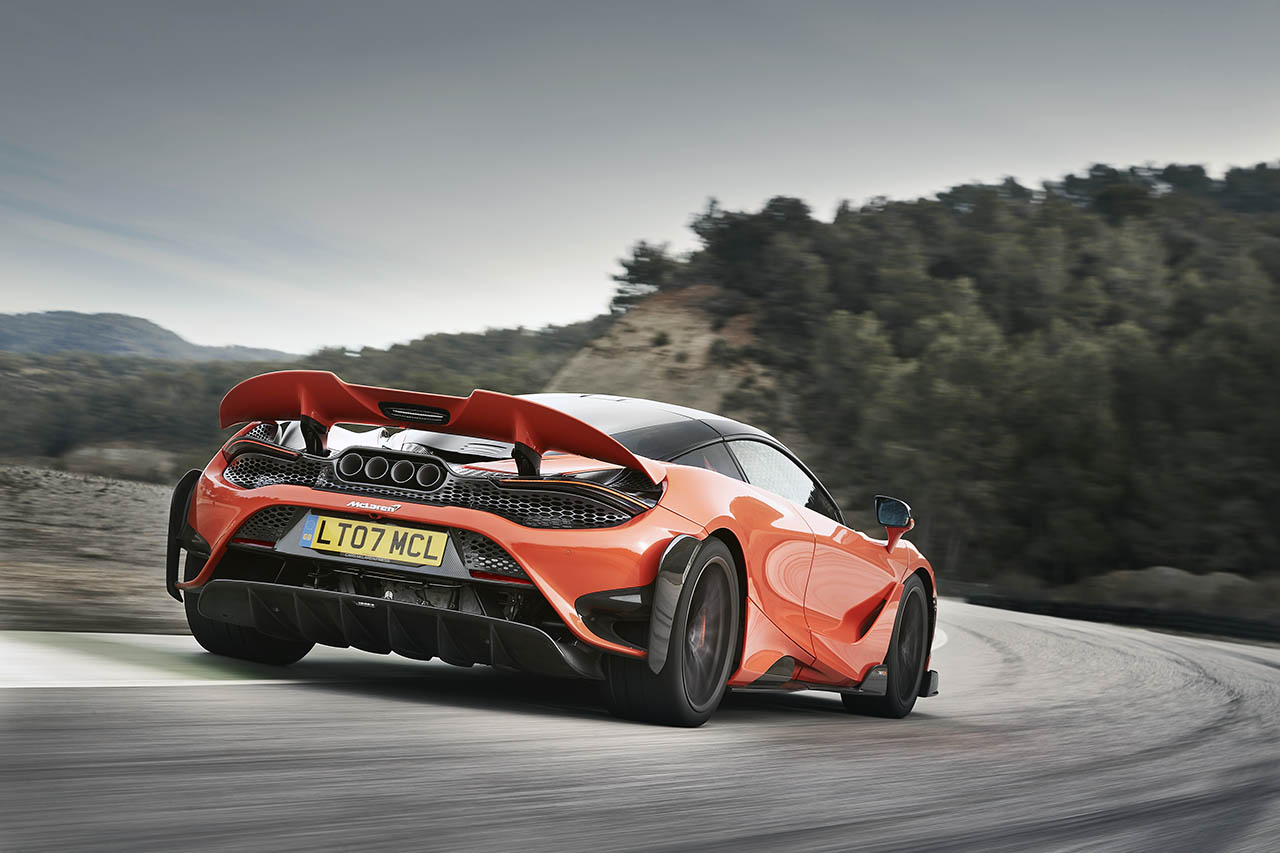
The 765LT weighs 80kg’s less than the 720S, and if you want ultimate performance, you can tell McLaren to throw out the air-conditioning, rip out the carpet, and ditch the audio system. In completely dry form the LT weighs just 1229kg.
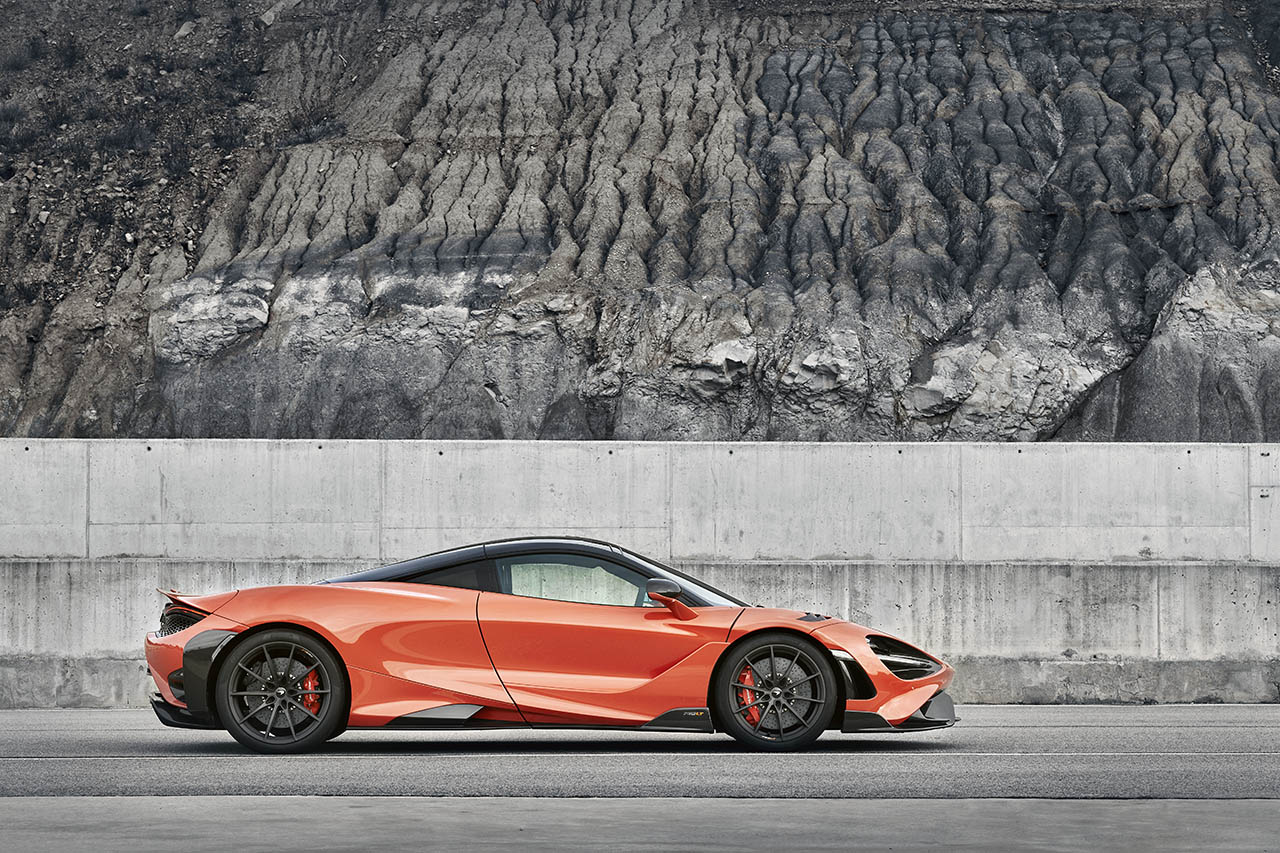
At the heart of it all is a 4.0-litre, twin-turbo V8 engine that is paired to a 7-speed dual-clutch gearbox that catapults the car to 100km/h in just 2.7 seconds. 200km/h takes just 7.2 seconds.
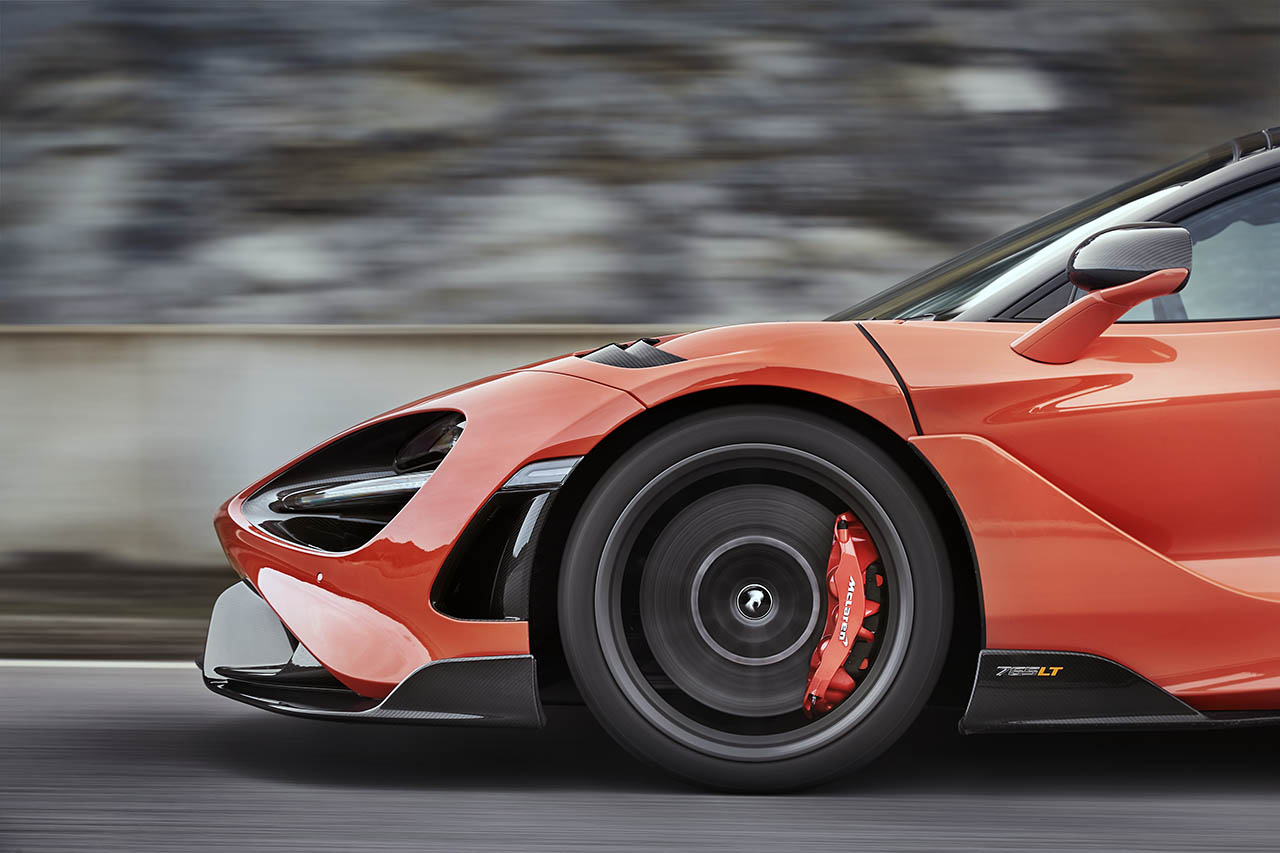
With great acceleration comes great stopping power, and so the 765LT borrows its braking power from the other incredible car it created not too long ago – the McLaren Senna. The brakes from the Senna feature Formula-One style cooling ducts to keep the roots from overheating, and so you can rest assured that the brakes will never fail on you after a heavy track day.
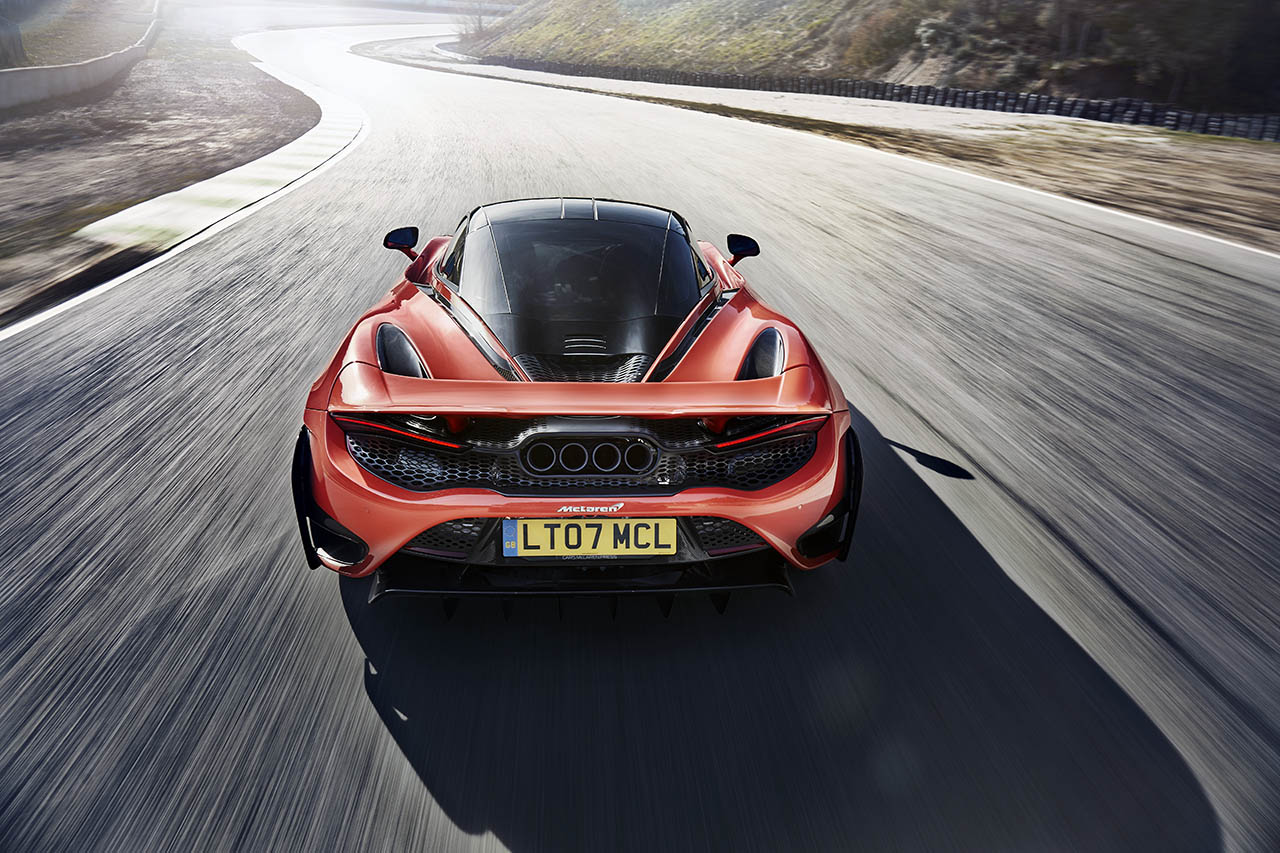
Mclaren is a bespoke hypercar manufacturer, and with that comes a level of customisation not seen in other supercars. So you can basically have your Mclaren any way you want it, the only limitation being the depths of your pocket.
Only 765 units of the 765LT will be built and 10 have been made it to Malaysia – and all have already been sold. Price is at RM1,488,000 before taxes and options. We estimate price with taxes and options to be at over RM3,000,000.
Car dealerships used to start off just as small showrooms selling just new cars, while the aftersales aspect was elsewhere or left to another party also involved in the same brand which had a service centre. However, as the profit from just selling cars alone is not significant, dealerships have expanded their scope of services to include aftersales service, preferably at one location for customer convenience.
Unitedstar Corporation Sdn Bhd, an authorised Toyota dealership located in Petaling Jaya, Selangor, has evolved in such a manner since beginning its business with the brand 15 years ago. Today, its outlet in the Taman Mayang area has been upgraded and offers both sales and aftersales services.
Toyota dealer for 15 years
“Unitedstar Corporation has been an authorised Toyota dealership since 2005, with just a showroom for sales at Aman Suria, Damansara followed by new 3S centre at Taman Nilai Perdana, Seremban in 2019. UMW Toyota Motor is pleased to see that the success and growth of the business has led to this upgrading. Broadening their scope of services to customers is in line with our “Customer First” philosophy,” said Ravindran K., President of UMW Toyota Motor.
The upgraded outlet is located in close proximity to large local communities and commercial growth areas. Its fully equipped service centre has 10 bays to provide efficient and speedy servicing daily. There are around 20 personnel who have received specific training to maintain Toyota vehicles and keep them in tip-top condition.
“This modern and inviting dealership reflects Toyota’s high standards in customer care. Throughout the world, Toyota dealers give priority to providing the best possible experience, including the highest standard of aftersales services,” said Akio Takeyama, Deputy Chairman, UMW Toyota Motor.
To locate Toyota showrooms or service centre in Malaysia, visit toyota.com.my.
Two more UMW Toyota Motor branch outlets transferred to dealers
After releasing the facelifted i30 model at the beginning of this year, Hyundai is now ready to follow up with an updated i30N, the high-performance version described as being ‘focused on dynamic performance, emotion and statement’.
In a series of official images being distributed worldwide, the refreshed looks show a new front end with aggressive-looking front and rear bumpers. The wide centre grille is flanked by new LED headlamps with DRLs having v-shaped light signatures.
The wheels on the car are said to be newly-developed and 19 inches in diameter. Of forged alloy, they are lighter than those of the previous i30 N, contributing to weight reduction in the car.
8-speed N-DCT
While the car will continue to use a 2-litre turbocharged 4-cylinder engine, possibly tuned to generate additional output, the transmission will be available the company’s 8-speed dual clutch unit (N DCT). This will be Hyundai’s first car model in Europe to have the 8-speed DCT and for the i30N, it will have dedicated N performance shifting functions.
N DCT, which was installed in the Veloster N in April, is equipped with electronic actuators that operate the double clutch. Unlike a dry double-clutch transmission, the wet N DCT uses oil to significantly improve lubrication and cooling performance, which is typical of higher torque applications, while avoiding reliability issues.
Adding more fun to driving
The N DCT comes with video game-like features that add fun to driving. N Grin Shift increases torque by 7% by allowing turbocharger overboost and maximizes transmission response for 20 seconds – performance that Hyundai N engineers are certain will induce ‘driver grin’.
Additionally, N Power Shift engages when the car accelerates with more than 90% of throttle, thereby mitigating any reduction in torque by using upshifts to deliver maximum power to the wheels. This gives the driver a responsive feeling of dynamic acceleration when shifting.
The N DCT also comes with N Track Sense Shift that discerns when road conditions are optimal for dynamic driving and activates automatically, selecting the right gear and shift timing just like a professional racing car driver to provide optimal performance.
In its time, many variations of the Mini were created, providing simple and affordable transport. One variation, though not promoted as part of the Mini range, was the MOKE. Designed in the 1960s by Sir Alec Issigonis, the father of the original Mini, it shared components (suspension and chassis) with the Mini.
Perhaps it was not promoted commercially initially because it was first intended for military use. So it was engineered to be robust enough for deployment behind enemy lines after being transported by aeroplane. However, the armed forces found the small wheels and low ground clearance to be unsuitable in the sort of terrain they would operate in. Although its exceptionally light weight may have been advantageous on soft ground, it didn’t even have 4×4 to help it in more difficult areas.
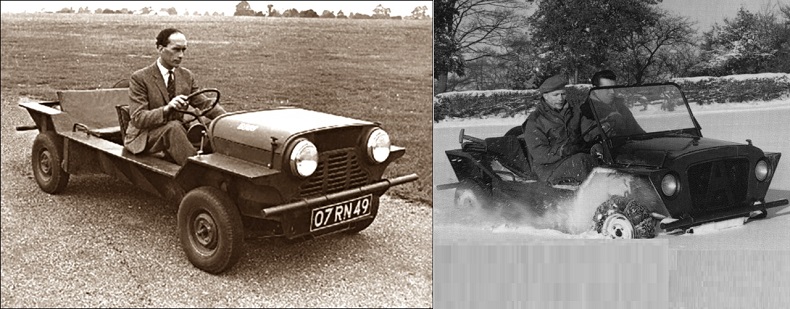
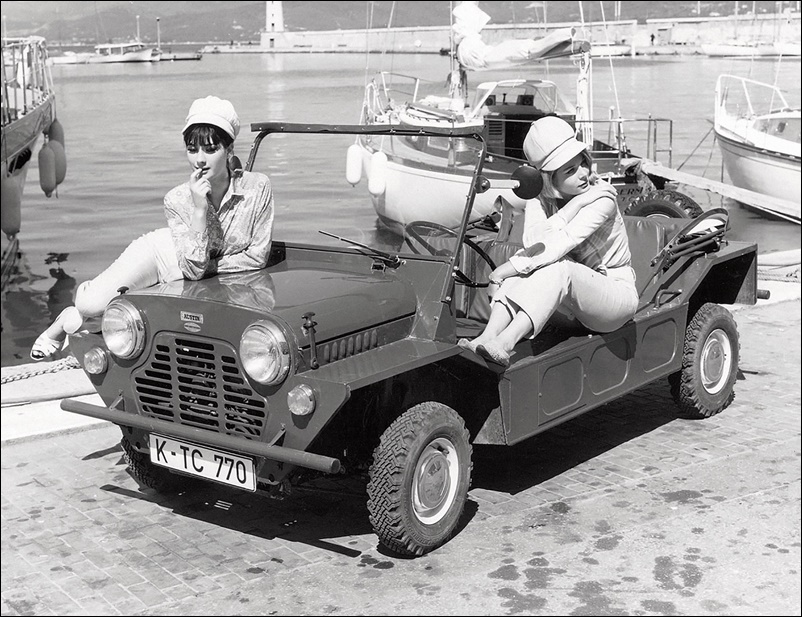
A cult car of the 1960s
Instead, the MOKE, as it came to be known, was then promoted as a civilian vehicle and it became a cult car like the dune buggy of the 1960s. It was popular transport for the inhabitants of the most exclusive coastal resorts in Europe, the Caribbean, USA and Asia. Many are still in use up till today at seaside resort and recreational facilities.
Some 50,000 units were produced at factories in the UK (1964 – 1968), Australia (1966 – 1981) and Portugal (1980 – 1993). The final production in Portugal was done by Cagiva, the Italian motorcycle manufacturer, which had acquired the ‘MOKE’ name.

Bringing back the MOKE
Now a company known as MOKE International Limited, which has owned the original ‘MOKE’ trademark since 2015, is offering – only to the UK market – a strictly limited run of 56 cars. The number has significance: it refers to the number of years since the original Mini MOKE was launched.
Customers have a choice of 14 body colours and the Limited Edition ‘MOKE 56’ comes with the front grille and windscreen rails in chrome, a discrete Union Jack badge on the front wings, and a numbered plaque on the bonnet. Indicative ex-factory pricing starts at £20,000 (about RM107,000) and the company says that interest is high from resorts and private buyers.
Modernised version
MOKE International will also be making the vehicles for the Caribbean market and will launch additional models across Europe, the USA and other markets in 2021. All MOKE bodies will be engineered and sub-assembled in Britain and then shipped to a factory in France for final assembly.
Naturally, the engineering has been updated to meet regulations that never existed in the 1960s. Besides a new 4-cylinder, EFI DOHC 1083 cc engine, there is uprated suspension, an updated brake system and the option for either automatic or manual transmission.
The modern MOKE is also slightly larger to provide more cabin space. Features previously viewed as a luxury like power steering and heated windscreen will come as standard.
Although there have been signs of the COVID-19 pandemic easing, the authorities warn that we are still not safe yet and precautions must still be taken to prevent the spread of the coronavirus. For that reason, the RMCO will continue till the end of the year.
Perodua has been doing its part to help in providing protection to the public, especially schoolchildren, and it has earlier been distributing thousands of face shields. It has also donated other much-needed items for use by frontliners.
The Malaysian carmaker is continuing with its public protection initiative and recently contributed over 7,700 face shields to 66 primary schools in the Putrajaya and Hulu Selangor vicinities lately. These are for the use of academic and support staff.
Extending goodwill to primary schools
“Having contributed some 11,000 face shields to secondary schools in Putrajaya and Hulu Selangor in June, Perodua now extends the same goodwill to primary schools in those areas,” said Perodua President & CEO, Dato’ Zainal Abidin Ahmad.
“We do this firstly for the protection, health and well-being of our beloved schoolchildren, teachers and support staff; secondly, as a token of appreciation to the Federal government for all their efforts in dealing with COVID-19; and thirdly, to give back to the local community we have called home for the past 27 years.”
Over 30,000 face shields distributed
Perodua has to date distributed over 30,000 face shields in total. Recipients have included the Putrajaya Federal Territory Education Department, the Hulu Selangor District Council, District Education Office and clinics, the Selayang Municipal Council and various morning and night market hawkers in Hulu Selangor and Selayang.
The face shields, manufactured by an associate of Perodua’s, feature a fog-resistant visor made of polyethylene terephthalate for optimal visibility, sponge cushioning that hugs the forehead to act as a barrier against airborne droplets, and an adjustable elastic band for a snug and comfortable fit.
“This Malaysia Day, Perodua, as a caring and responsible People First company, asks all Malaysians not to let their guard down. Please continue to be cautious and comply with all government health and safety guidelines, and we will defeat COVID-19 together as one nation,” Dato’ Zainal urged.
For those who want premium air quality in the premium cars they travel in, Volvo’s new Advanced Air Cleaner technology can satisfy that expectation. The technology is a world-first premium to provide Volvo drivers with clean and healthy air inside their cars and also clean the air of their cabin ahead of their journey.
While it may seem like the Swedish company is focusing on air cleanliness in view of global concerns brought on by the COVID-19 pandemic, Volvo has given attention to air quality in the cabin for decades. It was among the early carmakers to provide pollen filters and of course, it has continuously developed technologies to ensure that its exhaust emissions from its engines are as clean as possible.

Measuring and cleaning
The system has a sensor that measures PM 2.5 levels inside the cabin, creating a feature not available in any other car currently on the market. Indicating the amount of fine particulate matter in the air, PM 2.5 is a widely used measure for air quality. Globally, many urban areas suffer from PM 2.5 values that exceed recommended levels by the World Health Organisation, underlining the need to minimize their impact.
In China, where PM 2.5 measurements and related information services are well established, Volvo drivers can also compare air quality inside the cabin to that outside the car.
Available on all 60-series and 90-series Volvo models based on the Scalable Product Architecture (SPA) since early this year, the Advanced Air Cleaner uses a synthetic fibre-based filter and ionization to clean the air. Up to 95% of all PM 2.5 particles can be removed with these two methods.
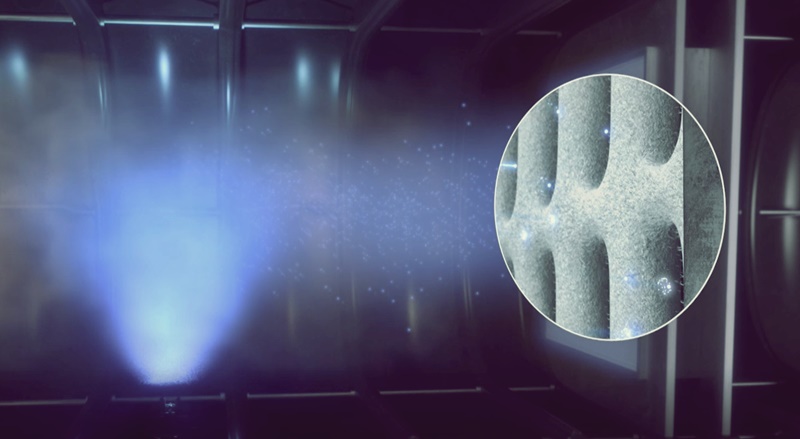
Healthier air means safer driving
With the greater air filtration, air quality inside the car is much healthier, limiting the adverse health effects that are associated with air pollution and fine particulates. Cleaner air inside the car also helps make driving safer as healthy and fresh air can help boost driver concentration.
Stale air tends to make a driver sleepy too, which is why the air inside needs to be refreshed periodically by opening the windows or switching to fresh air mode for the ventilation system. However, as external air quality is not clean, this is where Volvo’s Advanced Air Cleaner technology is very useful to clean it as it enters the cabin.
Drivers of certain Volvo models can also use the Volvo On Call smartphone app (where available) to easily schedule an extra cleaning of the cabin air ahead of their journey. The app then tells drivers about the actual PM 2.5 levels inside the cabin after cleaning.

“With our Advanced Air Cleaner technology, you can rest assured that the air you breathe inside your Volvo is cleaner and healthier,” said Anders Lofvendahl, Senior Technical Expert on Cabin Air Quality at Volvo Cars. “We believe that clean air is good for you, both from a health and from a safety perspective, and we will continue to push the envelope in this area.”
Apart from the Advanced Air Cleaner technology, Volvo Cars also works on creating a healthy environment inside its cars in other ways. Its engineers have a long-standing focus on removing emissions from organic substances in the car. They also aim to minimize the amount of allergy-causing materials from its interiors as well as generation and emission of odours from parts and materials used inside the cabin.
Geely Auto looks at ‘passenger safety’ from a different perspective, aims to make cars ‘healthier’
The epitome of what driving pleasure is all about – the sportscar – will never go away. In spite of periods when the numbers declined and many carmakers decided that they could not afford the luxury of making such cars, the voices of the enthusiasts around the world (and also within the company) have brought back sportscars.
The Nissan Z is one such example. An icon among sportscars, it was among the first from a Japanese brand and it made a tremendous impact, especially in America where the biggest number has been sold in its 50-year existence.
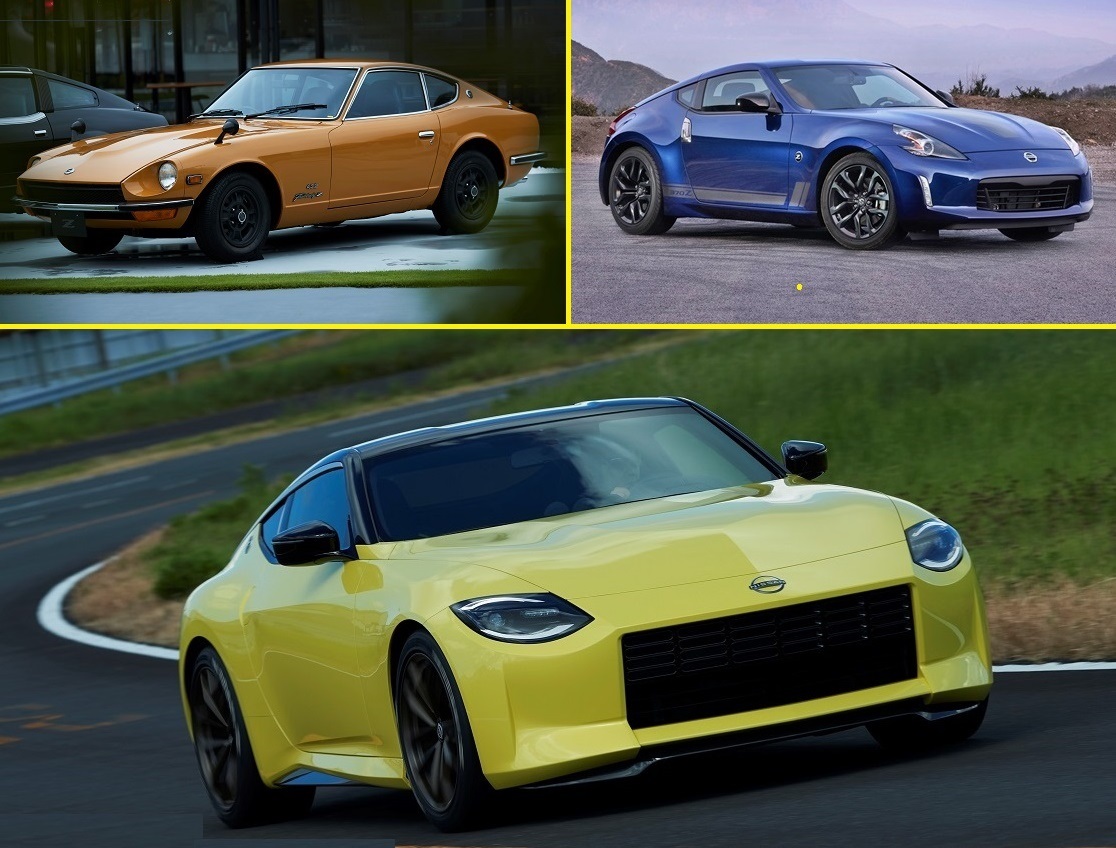
Other than a short break in the early 2000s when Nissan was recovering from financial difficulties, the Z has had a presence in the Nissan range with the generation on sale since 2009 being the sixth one.
Soon a seventh generation will be launched and it will be a totally new design with new technologies, as would be expected after a lapse of some 10 years. Nissan gave an online preview of the model – referred to as the ‘Z Proto’ for now – today from its base in Yokohama, Japan, with a clear promise that ‘the new Z is on its way’.
It wasn’t difficult to understand the excitement and passion of the original Z and earlier generations as many people involved in the project had memories of the sportscar and even owned it, including Nissan CEO Makoto Uchida, who introduced the Z Proto.
Past meets future
The design of the Z Proto was done largely in Japan and while feedback was considered from many markets, Hiroshi Tamura, Chief Product Specialist of the Z Proto, admitted that the comments of the Z community in America were influential simply because it is where the most Zs have been sold.
Given the heritage of the car, it’s only expected that the designers would constantly look back at past generations, especially the very first one, for inspiration and guidance. The long-nose silhouette, in particular, is a must for the Z but the retro theme is also combined with projected futurism.
“Our designers made countless studies and sketches as we researched each generation and what made them a success,” said Alfonso Albaisa, Head of Design at Nissan. “Ultimately, we decided the Z Proto should travel between the decades, including the future.”
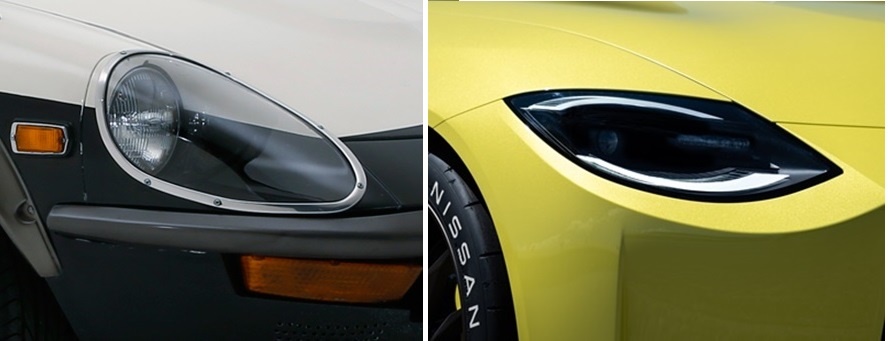
The shape of the bonnet and the canted, teardrop-shaped LED headlights are both unmistakable reminders of the original Z. “The LED headlights have two half-circles that hark back to the Japan market-only 240ZG of the 70s,” Albaisa explained. “The ZG had clear dome lenses over the headlight buckets, which under light give off two circular reflections over each headlight. We liked that unique characteristic and discovered that it naturally fit with the Z’s identity.”
The rectangular grille’s dimensions are similar to the current model with the addition of oval grille fins to offer an updated modern look. However, the link to the original Z is most striking when viewing the Z Proto from the side. The roofline flows from the nose to the squared-off rear to create a distinctive first-generation Z profile whose rear edge was slightly lower than the front fender height giving the Z its unique posture. The signature transition from the rear quarter glass to the low-slung position of the rear tail adds to the effect.
The rear takes inspiration from the 300ZX (Z32) taillights, reinterpreted for the modern world. Set within a rectangular black section that runs across the rear and wraps around the outer edges, the LED taillights convey a sharp glow.
Sharp-eyed readers may notice that the badge on the rear says ‘Fairlady Z’ and this could be a bow to the original legendary car. It might also be used for the future domestic model since the name does have a historical connection to the Japanese fans and owners.
Vintage touch, modern feel
The Z Proto’s cabin blends modern technology with vintage Z touches. The interior design team sought advice from professional motorsports legends to create an ideal sportscar cabin, both for road and track.
This can be seen in the Z’s instrumentation, a 12.3-inch digital display with all the information the driver needs to have. The tachometer is the dominant item with a digital speedometer and vital information is arranged to help the driver grasp it at a glance, such as the redline shift point at the 12 o’clock position.
It’s difficult to replicate the original steering wheel of the Z due to safety requirements but the designers have still tried to keep some vintage aesthetic. It is deeply dished and the driver has quick access to controls with switches on the left and right spokes.
Although digital display screens can be designed to provide the driver with all kinds of information and free up space on the dashboard, the designers have still retained that old-school sportscar look with three small round meters placed on top of the dashboard. In the Z Proto, these show boost pressure, turbocharger rpm and voltage although the ones in the production car might show other information.
Yellow accents are found throughout the cabin, including stitching on the instrument panel. The seats feature special yellow accenting and a layered gradation stripe in the centre of the seats to create depth. Incidentally, the bright yellow pearlescent paint of the exterior is a tribute to a popular paint scheme on both the first generation Z and the 300ZX (Z32).
6-speed manual gearbox lives on
Although the Z is about more than power increases, each new generation has nevertheless had a more powerful engine and the new Z can be expected to continue to provide punchy performance. “Z is a balance of power and agility,” said Tamura. “It is a vehicle that creates a connection with the driver not just on the physical level, but emotionally, and responds to the driver’s impulses.”
For this reason, Nissan will continue to offer a 6-speed manual gearbox. There’s usually not much to say about a manual transmission, unlike automatic transmissions which have constantly improved with advancements in electronic control technologies.
However, 12 years ago, Nissan did draw a lot of attention to its manual transmission in the new 370Z which had the world’s first synchronized downshift rev-matching system. Known as SynchroRev Match, the system blips the throttle just prior to downshifts and upshifts to match engine speed to the next gear. The result is a smoother transition which used to be only possible by drivers who knew about ‘heel-and-toe’. This feature should still appear in the new Z.
Will it be called ‘400Z’?
50 years ago, Yutaka Katayama – regarded as the ‘father of the Datsun Z’ – bravely removed the ‘Fairlady’ badges on the cars that arrived in America. The man in charge of Nissan’s subsidiary in America understood that ‘Fairlady’ (which was the chosen by Nissan’s President after he saw ‘My Fair Lady’, the play) was just not right for such a sportscar. So he chose something from the internal coding (Z432) and used just ‘Z’ to designate the new car. Which worked superbly and started a legendary line of sportscars.
The new Z will have the model code ‘Z35’ to follow the sequence that began in 1984 with the 300ZX. Rumours are that it will be badged ‘400Z’. Nissan does have a version of the VQ engine with a 4-litre displacement but this is designed for SUV applications so the ‘400Z’ would likely have an updated 3.7-litre unit as Nissan confirms it will be an ‘enhanced V6 twin-turbocharged engine’. Production is set to start next year so it would probably be in showrooms sometime in the second half of 2021.
Three years after the Zhejiang Geely Holding Group (Geely) took on a 49.9% equity in Proton, the carmaker is about to launch a second brand new model – the X50. Like the X70, it is also a SUV, catering to the most active segment globally.
It is also a model adapted from one which Geely developed and launched in August 2018 – the Binyue (Coolray outside China) – like the X70, which is why Proton can get completely new models into the market in such a short time. Normally, a new model would take a few years to develop but adapting from an existing model means the main time-consuming (and expensive) engineering work has been done already.
However, just as in the case of the X70 (known as the Boyue in China), a Proton version was not merely doing cosmetic changes and putting a different brand badge on. Until Proton launched the X70, there was no righthand drive version of the model anywhere in the world. And that meant additional engineering work which was more than just moving the steering wheel to the right side. Entirely new parts for righthand drive had to be made too, eg a different dashboard, power window switch panel, centre console, etc.
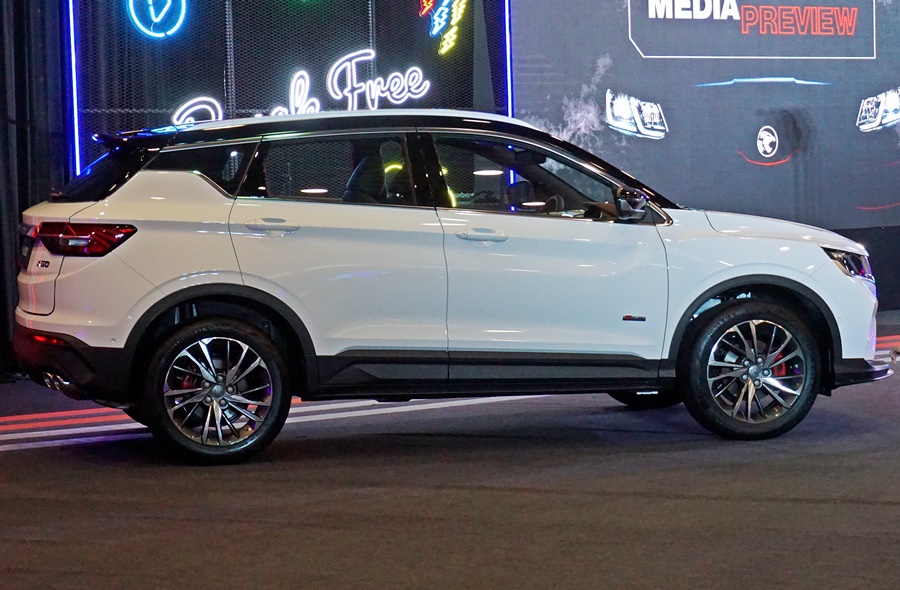
With the urgency to revive Proton and turn it around, the X70 was initially built in China and sent to Malaysia while the factory in Tg. Malim, which started operations almost 20 years ago, was renovated and improved. With that completed, X70 production was shifted to Malaysia and for the X50, Proton can start off right away making the model locally. And, like the X70 too, it will be the first (and for now, only) righthand drive version of the Binyue.
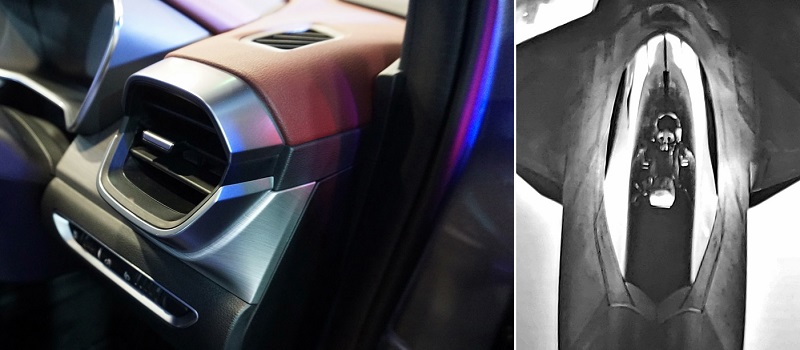
It is only to be expected that lessons learnt from developing the X70 have made the process of developing the X50 faster. For instance, Azlan Othman and his team at Proton DESIGN had to also get used to a new working culture while rushing work on the X70. With the X50, it would be safe to say they were ‘in the groove’ and also had a chance to ‘customize’ the model a bit more.
4 variants, 2 engine outputs
We don’t have the prices yet, but we do know that there will be 4 variants – Standard, Executive, Premium and, appropriately, Flagship. All of them will be powered by a 1.5-litre 3-cylinder petrol engine with turbocharging. However, the engine in the X50 1.5 TGDi Flagship will have a higher output of 177 ps/255 Nm as it has direct injection. The engine in the other three variants will have port injection and produce 150 ps/226 Nm.
All-wheel drive (AWD) may be nice to have but the cost-vs-benefit doesn’t work well in Malaysia and in any case, most customers don’t really care. So all X50 variants have front-wheel drive only, with a 7-speed dual-clutch transmission. For those who feel AWD gives better grip and stability in the wet, that argument is less relevant with the advanced electronic stability control and traction control systems available today.
More powerful GKUI 19
And talking of electronic systems, the X50 will have a newer generation of the Geely Key User Interface, or GKUI 19. Like computers and smartphones, the processing power of the system becomes greater over time as processors evolve. It also has a graphics processing unit (GPU) which helps in reducing demands on the main processor.
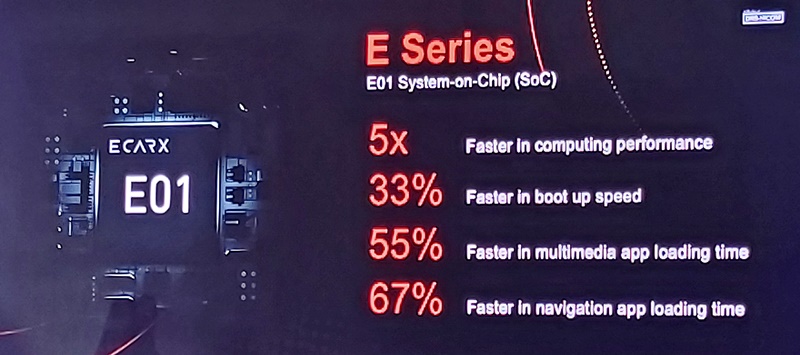
What this means to the user is more responsiveness – perhaps when ‘Hi Proton’ is said, the computer will spend less time ‘thinking’ before responding. Moving to a new generation gave the system designers a chance to revise and refine the interface, simplifying the menu structure while also offering a cleaner layout. The virtual buttons on the 10.25-inch touchscreen (8 inches for the Standard and Premium variants) are large, as they should be to make selection easier. The larger screen also has a resolution of 1920×720 px.
The navigation system in the X70 has sometimes been deficient and to partially address this, Proton has switched to a different digital mapping service. Whether it proves to be better remains to be seen when we get to test the new car. It would be good if there’s Apple CarPlay or Android Auto so smartphone apps like Waze or Google Maps can be transferred into the screen but the X50, like the X70, does not have them yet. It is, however, possible to interface using a mirroring function called QDLink.
An eSIM is provided for all variants, providing the necessary connectivity to the digital world. With the Premium and Flagship variants, it is also possible to start the engine as well as the air-conditioner without being inside the car. This is done using the Proton Link app which also allows setting the desired cooling temperature.
Idling the engine wastes petrol since the car is not going anywhere. But it is necessary if you want the luxury of having a cool cabin when you get in because the air-conditioner compressor needs to be powered. So the maximum time the engine is allowed to run is 10 minutes, after which it shuts down and so does the air-conditioner. If you do get in when the engine is running, you can also move off immediately so hopefully, the locking system is secure enough otherwise someone passing by can just get in and drive off!
Safety & ADAS
ABS with EBD and Brake Assist, Electronic Stability Control, Hill-start Assist, Hill Descent Control and Reverse Camera are standard active safety systems across the range. All variants also have a minimum of 4 airbags – front and sides – as well as ISOFIX points at the rear for compatible childseats. The Premium and Flagship variants have additional window curtain airbags and the camera system gives a 360-degree top-down view, as well as a tyre pressure monitoring system.
The X50 Flagship has an Advanced Driver Assistance System (ADAS) like the top version of the X70. However, the one in the new model is more advanced and can even operate with Level 2 autonomy. At this level, which is one of 5 levels, the brakes will activate automatically (if the driver does not act) if an accident is predicted as a vehicle or pedestrian are detected in front with the camera and radar.
The cruise control is also adaptive, adjusting the speed to maintain a safe gap and can even drop to standstill and resume moving in accordance with the vehicle ahead. Other ADAS features are keeping the car within a lane, automatically switching from high beam to low beam and a blind spot monitor.
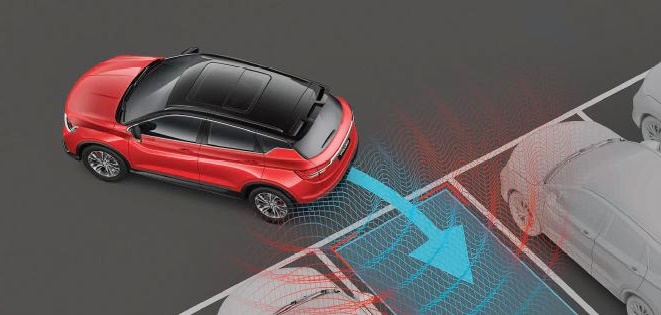
The X50 Flagship can also carry park itself, which should be welcome by those who find difficulty doing so. It’s an amazing system which uses the sensors around the body to position the car and all the driver has to do is work the accelerator pedal. Once this feature become standard in all vehicles, there won’t be a need for parking skill when taking a driving test!
Feature differences of each variant
The list of main differentiating features in each variant are shown below and you get 6 body colours to choose from.
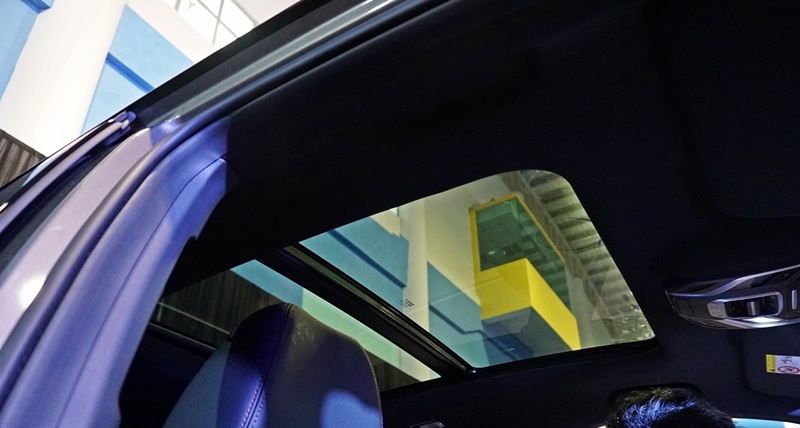
In the coming weeks leading to the official launch within a month’s time, we’ll be given more information on other aspects of the X50. As it will be launched within the period when the 10% sales tax is exempted, its price will differ from those registered after December 31, 2020 when the exemption incentive ends. So if you want to save money, order one quickly and it will cost you only RM500 to make a booking which will be accepted from tomorrow (September 16).
Vote for the X50 slogan
While the name has been revealed (not that it was a big secret, except that Proton never really confirmed it), the company is still undecided about the slogan to use for the new model. So, just as with the X70 when the public was invited to vote (for the model name), Proton is again inviting the public to vote for the slogan this time.
There are four slogans: Intelligence that Amazes, Intelligence that Leads, Intelligence that Exceeds, and Intelligence that Lives. We don’t see the page for voting tonight and maybe it will be open when bookings start tomorrow so visit www.proton.com to stay updated if you want to vote.
© Copyright – Piston.my 2024 Trademarks belong to their respective owners. All rights reserved